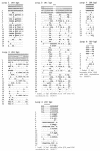Molecular typing of Neisseria gonorrhoeae isolates by pyrosequencing of highly polymorphic segments of the porB gene
- PMID: 15243040
- PMCID: PMC446322
- DOI: 10.1128/JCM.42.7.2926-2934.2004
Molecular typing of Neisseria gonorrhoeae isolates by pyrosequencing of highly polymorphic segments of the porB gene
Abstract
For prevention and control of gonorrhea, an objective, highly discriminating, and reproducible molecular epidemiological characterization of Neisseria gonorrhoeae is essential. In the present study, in pursuance of providing such qualities, pyrosequencing technology, a fast real-time DNA sequence analysis, was applied to six short, highly polymorphic porB gene segments, with subsequent genetic variant (genovar) determination of the bacterial isolates. The sequencing templates were obtained by real-time PCR amplification, which also included fluorescence melting curve analysis of the entire porB gene in order to determine the genogroup (porB1a or porB1b allele) prior to pyrosequencing analysis. The PSQ 96 MA system used allowed rapid (in approximately 1.5 h) determination of 96 sequences of 20 to 65 correct nucleotides each. The results were reproducible and mostly in concordance with the results of conventional Sanger dideoxy sequencing, with the exception of shorter read lengths and some uncertainty in determining the correct number of identical nucleotides in homopolymeric segments. The number of sequence variants identified in each of the six highly polymorphic segments of the porB1a and porB1b alleles (encoding surface-exposed amino acid loops of the mature PorB protein) ranged from 5 to 11 and from 8 to 39, respectively. Among porB1a isolates (n = 22) and porB1b isolates (n = 65), 22 and 64 unique genovars, respectively, were identified. All isolates were typeable. The present results provide evidence of a high discriminatory ability, practically the same as that for sequencing of the entire porB gene. In conclusion, the fast and high-throughput pyrosequencing technology can be used for molecular epidemiological characterization of N. gonorrhoeae.
Figures



Similar articles
-
Review and international recommendation of methods for typing neisseria gonorrhoeae isolates and their implications for improved knowledge of gonococcal epidemiology, treatment, and biology.Clin Microbiol Rev. 2011 Jul;24(3):447-58. doi: 10.1128/CMR.00040-10. Clin Microbiol Rev. 2011. PMID: 21734242 Free PMC article. Review.
-
Clusters of circulating Neisseria gonorrhoeae strains and association with antimicrobial resistance in Shanghai.J Antimicrob Chemother. 2008 Mar;61(3):478-87. doi: 10.1093/jac/dkm544. Epub 2008 Jan 27. J Antimicrob Chemother. 2008. PMID: 18227091
-
Comparison of serologic and genetic porB-based typing of Neisseria gonorrhoeae: consequences for future characterization.J Clin Microbiol. 2003 Sep;41(9):4141-7. doi: 10.1128/JCM.41.9.4141-4147.2003. J Clin Microbiol. 2003. PMID: 12958238 Free PMC article.
-
Molecular epidemiology of Neisseria gonorrhoeae: sequence analysis of the porB gene confirms presence of two circulating strains.J Clin Microbiol. 2002 Oct;40(10):3741-9. doi: 10.1128/JCM.40.10.3741-3749.2002. J Clin Microbiol. 2002. PMID: 12354874 Free PMC article.
-
Pyrosequencing: nucleotide sequencing technology with bacterial genotyping applications.Expert Rev Mol Diagn. 2005 Nov;5(6):947-53. doi: 10.1586/14737159.5.6.947. Expert Rev Mol Diagn. 2005. PMID: 16255635 Review.
Cited by
-
Molecular characterization of Neisseria gonorrhoeae identifies transmission and resistance of one ciprofloxacin-resistant strain.APMIS. 2007 Mar;115(3):231-41. doi: 10.1111/j.1600-0463.2007.apm_487.x. APMIS. 2007. PMID: 17367469 Free PMC article.
-
Molecular Typing of Neisseria gonorrhoeae Isolates by Opa-Typing and Ribotyping in New Delhi, India.Int J Microbiol. 2009;2009:934823. doi: 10.1155/2009/934823. Epub 2009 Sep 16. Int J Microbiol. 2009. PMID: 20016674 Free PMC article.
-
Review and international recommendation of methods for typing neisseria gonorrhoeae isolates and their implications for improved knowledge of gonococcal epidemiology, treatment, and biology.Clin Microbiol Rev. 2011 Jul;24(3):447-58. doi: 10.1128/CMR.00040-10. Clin Microbiol Rev. 2011. PMID: 21734242 Free PMC article. Review.
-
Evaluation of Neisseria gonorrhoeae multiple-locus variable-number tandem-repeat analysis, N. gonorrhoeae Multiantigen sequence typing, and full-length porB gene sequence analysis for molecular epidemiological typing.J Clin Microbiol. 2012 Jan;50(1):180-3. doi: 10.1128/JCM.05386-11. Epub 2011 Nov 9. J Clin Microbiol. 2012. PMID: 22075591 Free PMC article.
-
Detection of three closely located single nucleotide polymorphisms in the EAAT2 promoter: comparison of single-strand conformational polymorphism (SSCP), pyrosequencing and Sanger sequencing.BMC Genet. 2014 Jul 5;15:80. doi: 10.1186/1471-2156-15-80. BMC Genet. 2014. PMID: 24996834 Free PMC article.
References
-
- Butt, N. J., M. Virji, F. Vayreda, P. R. Lambden, and J. E. Heckels. 1990. Gonococcal outer-membrane protein PIB: comparative sequence analysis and localization of epitopes which are recognized by type-specific and cross-reacting monoclonal antibodies. J. Gen. Microbiol. 136:2165-2172. - PubMed
-
- Chow, V. T. K., Q. C. Lau, and C. L. Poh. 1994. Mapping of serovar-specific monoclonal antibody epitopes by DNA and amino acid sequence analysis of Neisseria gonorrhoeae outer membrane protein IB strains. Immun. Infect. Dis. 4:202-206.
-
- Cooke, S. J., K. Jolley, C. A. Ison, H. Young, and J. E. Heckels. 1998. Naturally occurring isolates of Neisseria gonorrhoeae which display anomalous serovar properties, express PIA/PIB hybrid porins, deletions in PIB or novel PIA molecules. FEMS Microbiol. Lett. 162:75-82. - PubMed
-
- Cooke, S. J., H. de la Paz, C. L. Poh, C. A. Ison, and J. E. Heckels. 1997. Variation within serovars of Neisseria gonorrhoeae detected by structural analysis of outer-membrane protein PIB and by pulsed-field gel electrophoresis. Microbiology 143:1415-1422. - PubMed
Publication types
MeSH terms
Substances
LinkOut - more resources
Full Text Sources
Other Literature Sources
Molecular Biology Databases

